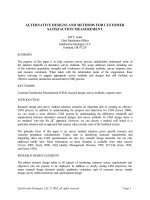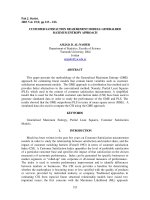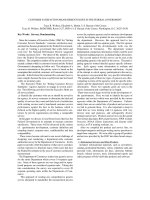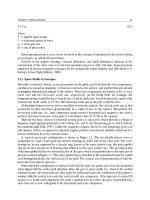Alternative designs and methods for customer satisfaction measurement
Bạn đang xem bản rút gọn của tài liệu. Xem và tải ngay bản đầy đủ của tài liệu tại đây (218.57 KB, 9 trang )
SatisFaction Strategies, LLC © 2002, all rights reserved Page 1
ALTERNATIVE DESIGNS AND METHODS FOR CUSTOMER
SATISFACTION MEASUREMENT
Jeff T. Israel
Chief Satisfaction Officer
SatisFaction Strategies, LLC
Portland, OR 97229
SUMMARY
The purpose of this paper is to help customer survey process stakeholders understand some of
the inherent tradeoffs of alternative survey methods. The scope addresses factors including size
of the customer population, strengths and weaknesses of alternate methods, survey response rates
and resource constraints. When taken with the information needs of the organization, these
factors converge to suggest appropriate survey methods and designs that will facilitate an
effective customer satisfaction measurement (CSM) process.
KEY WORDS
Customer Satisfaction Measurement (CSM), research design, survey methods, response rates
INTRODUCTION
Research design and survey method selection comprise an important part of creating an effective
CSM process. In addition to understanding the purpose and objectives for CSM (Israel, 2000),
we can create a more effective CSM process by understanding the differences (tradeoffs and
implications) between alternative research designs and survey methods. In CSM design, there is
no standard “one-size fits all” approach. However, we can choose a method well suited to a
particular situation and an approach that ensures value exceeds costs of the feedback system.
The principle focus of this paper is on survey method selection given specific resource and
customer population considerations. Topics such as identifying customer requirements and
integrating them into CSM questionnaires are also key research design elements, but are only
addressed briefly here. More information on these elements is available from other sources
(Vavra, 2002; Israel, 2000; ASQ Quality Management Division, 1999, 235-246; Israel, 1994;
and Israel, 1992).
RESEARCH DESIGN ELEMENTS
The phrase research design refers to all aspects of translating customer survey requirements and
objectives into the process to be deployed. In addition to clearly stating CSM objectives, the
major research design elements include: qualitative evaluation; type of customer survey; sample
design; survey method selection; and, questionnaire design.
SatisFaction Strategies, LLC © 2002, all rights reserved Page 2
Qualitative evaluation normally follows the initial statement of CSM objectives. Qualitative
methods most commonly entail depth interviews (one-on-one) or focus groups conducted with
various external customer groups (segments). Qualitative customer data gathering is used to
identify and clarify customer requirements and the primary components of value exchange.
Results from qualitative research may not be projected to all customers but is fundamental in
determining which aspects of product and service delivery should be included as metrics in the
CSM quantitative survey. Internal qualitative evaluation – targeted with employees who “own”
key service delivery processes – is another helpful way to identify customer requirements, and
also provides focus on areas critical to customer satisfaction. In addition, internal evaluation can
often lead to significant service process improvements (Israel, 1994).
The types of customer surveys most often used for measuring customer satisfaction include
general customer satisfaction tracking and transaction satisfaction tracking, determined by
whether the population is defined in terms of customers or transactions. Other types of CSM
surveys include new customer surveys and lost customer surveys. New customer surveys help
ensure customer relationships get off on the right foot (i.e., high initial quality), while lost
customer surveys can help identify root causes of problems driving customers into the arms of
the competition.
Sample design refers to how we define who the customer is (population), how we can contact
them (sample frame) and the actual sampling method to be used. The population may be all
customers (N); selected segments of “core customers” (N
C
); or, the universe of all qualified
transactions in a certain time period (N
QT
). The sample frame is the list of customers or
transactions used to represent the population. Accurate customer databases and effective
Information Technology (IT) capabilities are highly desirable in deploying CSM. Actual survey
samples are drawn from the lists of customers or transactions contained in the sample frame.
Simple random samples are used when the population is viewed as homogenous. When distinct
customer segments are the focus, stratified random sampling is more appropriate. Sample
frequency may range from real-time continuous (transaction surveys) to once every two years.
Survey method selection (whether electronic, mail, phone, in-person, or some combination) may
be made based on a number of factors. Population size, likely response rates, core vs. non-core
supplier relationship with customers, CSM resource requirements (budget / staff resources), and
desired data quality are all important factors in deciding which survey method to use. In next few
sections of the paper, the relative advantages and disadvantages of the alternative survey
methods are presented and tradeoffs of important factors are explored.
Questionnaire design and construction is one area where special expertise (whether internal or
external) is called for. Care must be taken; to ask the right questions; ensure questions accurately
reflect customer requirements; use the right types of scales; and, to avoid biased wording or
question order. It is important that the survey conveys professionalism and sincerity to your
customers. Regardless of the type of CSM survey, questionnaires should include: quantitative
metrics for both satisfaction outcomes and processes; qualitative questions to clarify
improvement opportunities and customer requirements; and, questions to aid meaningful
customer segmentation.
SatisFaction Strategies, LLC © 2002, all rights reserved Page 3
COMPARISON OF ALTERNATIVE SURVEY METHODS
Several survey methods may be used to collect CSM data. The most commonly used include
mail, electronic, telephone, in-person, or some combination of methods (hybrid). Each method
has inherent advantages and disadvantages. The distinctions between methods usually impact the
suitability of a particular survey method relative to the organization’s specific CSM information
needs. The following table highlights key advantages and disadvantages of alternative survey
methods across a number of key survey comparison categories.
CSM Survey Method
Comparison
category:
Electronic Mail Phone In-person Hybrid
Likely
response rate
Low –
medium
(10 to 50%)
Low –
medium
(10 to 50%)
High
(35 to 85%)
Very high
(65 to 100%)
High
(35 to 85%)
Effectiveness
for non-core
suppliers
Low –
medium
Low –
medium
High High
Depends on
methods
When target
respondent
unknown
Poor
(excluded)
Poor – fair
(rerouted)
Very good Very good
Depends on
methods
Value in
building
relationships
Fair Fair Good Excellent
Depends on
methods
Survey length
limitations
Short, 5”-10”
Comment
questions
limited
Short, 5”-10”
Comment
questions
limited
Medium,
10”-20”
Long,
30”-90”
Short /
Medium
Qualitative
data quality
(comments)
Fair – Poor Fair – Poor Very good Excellent
Depends on
methods
Quantitative
data quality
Good Good Very good Excellent
Depends on
methods
Cost per
survey
Lowest Moderate High Highest Blended
On review of the information in the table, in-person surveys are ranked best in all categories
except cost. Because costs are very high, in-person is often only practical when the desired
sample size is relatively small, or when the value of a particular customer population warrants
the additional expense. In-person surveys can add extraordinary value in customer relationship
management (CRM) initiatives (Israel, 1997).
Phone surveys are probably used more often than any other method. While response rates can
vary widely, non-response bias is less a concern than it is for mail or electronic surveys (ASQ
Quality Management Division, 1999). Like in-person methods, quality for both quantitative and
qualitative data (comments) is very high. Customers answer a higher percentage of questions in
SatisFaction Strategies, LLC © 2002, all rights reserved Page 4
general and interviewers are able to probe and clarify any vague or incomplete responses. While
still fairly expensive, phone surveys cost considerably less than in-person surveys. When the
customer perceives the products or services provided by your company as “less critical” than
other key suppliers, phone surveys will be more successful than less obtrusive methods (mail /
electronic).
Poorly executed mail and electronic surveys commonly yield disappointing response rates (10%-
15%). However, there are many tactics that may be employed to improve response rates, both for
mail surveys (Dillman, 1978) and electronic survey methods. Electronic surveys are probably the
easiest to administer and also the lowest in total cost (even when making additional efforts to
secure higher response rates). Mail surveys are similar in being simple to administer and highly
cost effective. Perhaps the biggest negatives for these methods are related to data quality.
Customers my skip some questions (on purpose or by accident). If provided, their comments may
be vague or unspecific. Survey length must be kept short in order to maintain reasonable
response rates.
Electronic surveys have some other limitations. Not all customers have access to email or the
web at work, so it may not be practical to use this method for all customers. Even if they do have
access to email and the web, it is fairly common for company databases to be inaccurate or
incomplete in fields like email address. If email address information is lacking or not up-to-date,
some customers will be excluded and survey results will be biased accordingly.
Hybrid methods present some interesting alternatives. Some companies use hybrid methods to
accommodate different sales channels (in-person, phone and web). Hybrid methods may also be
used to provide the customer with choices on how they can respond. For example, they can be
sent a mail survey but a URL with the survey web address can be included in the cover letter.
Another application is to begin with unobtrusive methods (email or mail). For core customers
who do not respond, follow-up phone surveys can be initiated to obtain needed sample sizes and
minimize non-response bias.
The key point of this discussion is that CSM method selection (and the resulting survey process
design) should be driven by a number of factors. While the above factors may suggest a
particular approach, it is very important to factor in some other key parameters. Population size,
desired sample size and required response rates may further influence the method selection
decision.
IMPACTS OF POPULATION, SAMPLE SIZE AND RESPONSE RATES
In the section detailing research design elements, a brief overview of sample design was
presented. In our choice of sample designs, we shouldn’t presume that compiling a single list of
all customers and drawing a simple random sample for the customer survey is the most desirable
sampling approach. It is often more beneficial to target specific customer segments or groups
according to the most critical information needs and specific survey objectives. For example,
given budget constraints, a company may have to choose between a CSM process that obtains a
statistically valid sample of all customers or a statistically valid sample of core customers, but
not both. Which approach would you choose?
SatisFaction Strategies, LLC © 2002, all rights reserved Page 5
This raises several sample design related questions. First, how do we define the population?
Second, should we attempt a sample or census? Third, if a sample, how big should the sample
size be? Finally, how will method response rates affect the achieved sample?
The table below has been prepared to illustrate important relationships between population size
(N), desired sample size (n) and actual sample required to achieve the desired sample. Please
note that desired sample size depends on the needed precision (expected variation) and the level
of acceptable sampling error. For illustration purposes, conservative sampling requirements have
been assumed. Also, the response rate estimates are meant to illustrate the relative differences
between methods. Actual response rates will vary depending on the ways methods are deployed
and should be expected to vary from one organization to another.
Impacts of Population Size, Sample Size and Response Rates on Method Selection
Sample Required
(Considering Probable Response Rates)
Population Size (N)
Desired Sample
Size (n)
(" 5% precision,
á=.05)
Electronic /
Mail (33%)
Telephone
(50%)
In-person
(80%)
Very small (N=30) n=28
Need 85 *
Max n=10
Need 56 *
Max n=15
Need 35 *
Max n=24
Small (N=500) n=216
Need 648 *
Max n=165
Need 432
Meet target
Need 270
Meet target
Medium (N=1,000) n=275
Need 825
Meet target
Need 550
Meet target
Need 344
Meet target
Large (N=10,000) n=364
Need 1092
Meet target
Need 728
Meet target
Need 455
Meet target
Very large (N=100,000) n=377
Need 1142
Meet target
Need 754
Meet target
Need 472
Meet target
The shaded cells in the table highlight situations where it is unlikely that desired samples sizes
could be achieved. For very small populations we may need to relax precision and acceptable
sampling error to achieve a statistically valid sample (e.g., " 7% precision and á=0.10). In other
words, if we accept more variation in our results (expand allowable precision range) and accept
higher levels of risk that our statistical inferences are incorrect (where á is probability of wrong
conclusion), the effect is to reduce the required sample size. The table also shows that electronic
and mail surveys with small populations are unlikely to attain desired sample sizes, even when a
census is attempted. We can conclude that when dealing with small customer populations
(including core segments) we may have no choice but to select a method that facilitates higher
survey response rates. In addition, this table underscores the value of making extra effort to
increase response rates, especially in the case of small populations.
NON-RESPONSE BIAS CONCERNS
With all surveys, non-response bias should always be a concern. Even if we are able to attain a
statistically valid sample, we must recognize that the results from our survey sample may or may
not reflect the perceptions of the entire population. Methods that are the most obtrusive









